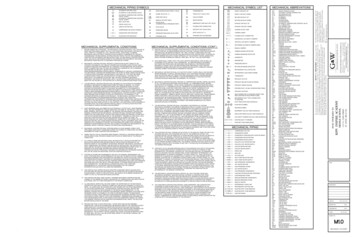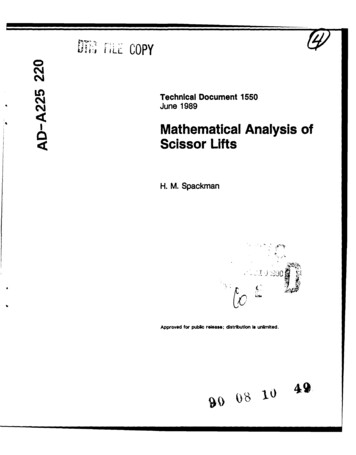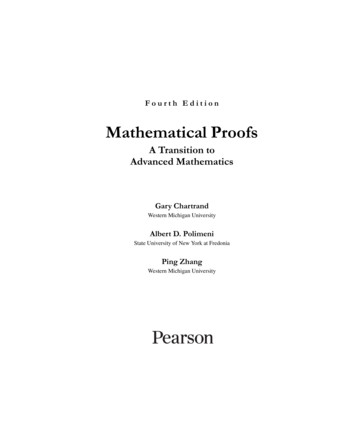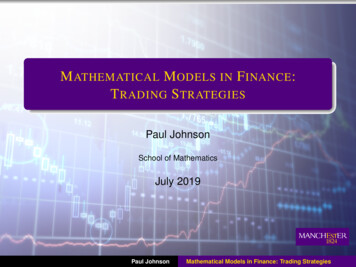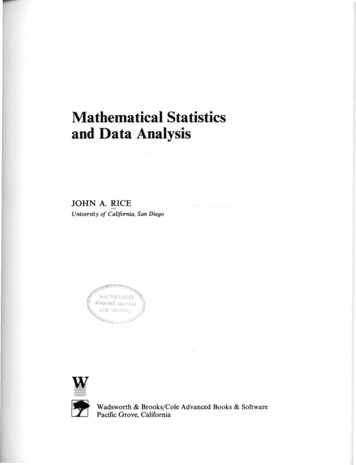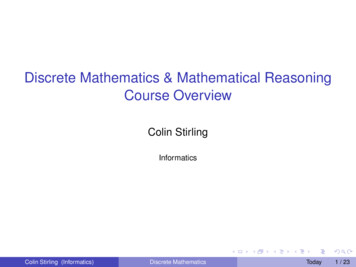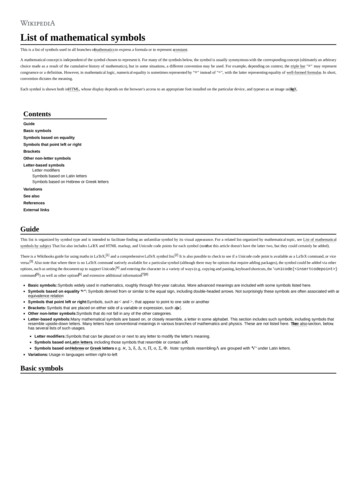
Transcription
List of mathematical symbolsThis is a list of symbols used in all branches ofmathematics to express a formula or to represent aconstant.A mathematical concept is independent of the symbol chosen to represent it. For many of the symbols below, the symbol is usually synonymous with the corresponding concept (ultimately an arbitrarychoice made as a result of the cumulative history of mathematics), but in some situations, a different convention may be used. For example, depending on context, the triple bar " " may representcongruence or a definition. However, in mathematical logic, numerical equality is sometimes represented by " " instead of " ", with the latter representing equality of well-formed formulas. In short,convention dictates the meaning.Each symbol is shown both inHTML, whose display depends on the browser's access to an appropriate font installed on the particular device, and typeset as an image usingTeX.ContentsGuideBasic symbolsSymbols based on equalitySymbols that point left or rightBracketsOther non-letter symbolsLetter-based symbolsLetter modifiersSymbols based on Latin lettersSymbols based on Hebrew or Greek lettersVariationsSee alsoReferencesExternal linksGuideThis list is organized by symbol type and is intended to facilitate finding an unfamiliar symbol by its visual appearance. For a related list organized by mathematical topic, see List of mathematicalsymbols by subject. That list also includes LaTeX and HTML markup, and Unicode code points for each symbol (notethat this article doesn't have the latter two, but they could certainly be added).There is a Wikibooks guide for using maths in LaTeX,[1] and a comprehensive LaTeX symbol list.[2] It is also possible to check to see if a Unicode code point is available as a LaTeX command, or viceversa.[3] Also note that where there is no LaTeX command natively available for a particular symbol (although there may be options that require adding packages), the symbol could be added via otheroptions, such as setting the document up to support Unicode,[4] and entering the character in a variety of ways (e.g. copying and pasting, keyboard shortcuts, the \unicode{ insertcodepoint }command[5]) as well as other options[6] and extensive additional information.[7][8]Basic symbols: Symbols widely used in mathematics, roughly through first-year calculus. More advanced meanings are included with some symbols listed here.Symbols based on equality " ": Symbols derived from or similar to the equal sign, including double-headed arrows. Not surprisingly these symbols are often associated with anequivalence relation.Symbols that point left or right:Symbols, such as and , that appear to point to one side or another.Brackets: Symbols that are placed on either side of a variable or expression, such as x .Other non-letter symbols:Symbols that do not fall in any of the other categories.Letter-based symbols:Many mathematical symbols are based on, or closely resemble, a letter in some alphabet. This section includes such symbols, including symbols thatresemble upside-down letters. Many letters have conventional meanings in various branches of mathematics and physics. These are not listed here. TheSee also section, below,has several lists of such usages.Letter modifiers: Symbols that can be placed on or next to any letter to modify the letter's meaning.Symbols based on Latin letters, including those symbols that resemble or contain anXSymbols based on Hebrew or Greek letters e.g. א , ב , δ, Δ, π, Π, σ, Σ, Φ. Note: symbols resembling Λ are grouped with "V" under Latin letters.Variations: Usage in languages written right-to-leftBasic symbols
SymbolSymbolin HTMLin TeXNameRead asExplanationExamplesCategoryadditionplus;add4 6 means the sum of 4 and 6.2 7 9A1 A2 means the disjoint union ofsets A1 and A2.A1 {3, 4, 5, 6} A2 {7, 8, 9, 10} A1 A2 {(3, 1), (4, 1), (5, 1), (6, 1), (7, 2), (8, 2), (9, 2), (10, 2)}36 11 means the subtraction of11from 36.36 11 25 3 means the additive inverse of thenumber 3. ( 5) 5arithmetic disjoint unionthe disjointunion of .and .set tive signnegative;minus;the oppositeof arithmeticset-theoreticcomplementminus;withoutA B means the set that contains allthe elements of A that are not in B.( can also be used for set-theoreticset theory complement as described below.){1, 2, 4} {1, 3, 4} {2}plus-minusplus or minus 6 3 means both 6 3 and 6 3 . The equation x 5 4 , has two solutions, x 7 and x 3 .arithmetic\pmplus-minus10 2 or equivalently 10 20%plus or minus means the range from10 2 tomeasurement 10 2 .minus-plus\mpminus or plusarithmeticIf a 100 1 mm , then a 99 mm and a 101 mm .6 (3 5) means 6 (3 5) and6 (3 5) .cos(x y) cos(x) cos(y) sin(x) sin(y).3 4 or 3 4 means the multiplicationof 3 by 4.7 8 56multiplicationtimes;multiplied byarithmeticdot productscalar product ·\times\cdotdotu v means the dot product ofvectorslinear algebra u and vvectoralgebracross productvectorproductcrosslinear algebravectoralgebrau v means the cross product ofvectors u and vA · means a placeholder for anargument of a function. Indicates thefunctional nature of an expressionfunctional without assigning a specific symbol foranalysis an argument.(1, 2, 5) (3, 4, 1) 6(1, 2, 5) (3, 4, 1) ij132 5 ( 22, 16, 2)4 1kplaceholder(silent)division(Obelus)divided by;over 6 3 or 6 3 means the division of6by 3.\divquotientgroupmod12 4 3G / H means the quotient of groupGmodulo its subgroup H.{0, a, 2a, b, b a, b 2a} / {0, b} {{0, b}, {a, b a}, {2a, b 2a}}A/ means the set of all equivalenceclasses in A.If we define by x y x y ℤ, thenℝ/ {x n : n ℤ, x [0,1)} .group theoryquotient setmodset theorysquare root(radicalsymbol) x means the nonnegative numberthe (principal) whose square is x.square root of\surd\sqrt{x} 2 4 0.5arithmetic · 4 2real numberscomplexsquare rootIf z r exp(iφ) is represented in polarthe (complex)coordinates with π φ π, thensquare root of z r exp(iφ/2).complexnumberssummation 1 i
\sumsum over .from . to .ofmeans.calculusindefiniteintegral orantiderivativeindefiniteintegral of f(x) dx means a function whose- OR derivative is f.theantiderivativeofcalculusdefiniteintegral \intintegral from. to . of .with respecttob a f(x) dx means the signed areabetween the x-axis and the graph of thefunction f between x a and x b.b 2b3 a3 a x dx 3calculusline integral Cf ds means the integral off alongbline/ path/the curve C, f(r(t)) r'(t) dt, whereacurve/ integralr is a parametrization ofC. (If the curveof . along .calculus is closed, the symbol may be usedinstead, as described below.)Similar to the integral, but used todenote a single integration over aclosed curve or loop. It is sometimesused in physics texts involvingequations regarding Gauss's Law, andwhile these formulas involve a closedsurface integral, the representationsdescribe only the first integration of thevolume over the enclosing surface.Instances where the latter requiressimultaneous double integration, the Contourintegral;closed lineintegral\ointcontourintegral ofsymbol would be more appropriate.A third related symbol is the closedvolume integral, denoted by the symbol .1If C is a Jordan curve about 0, then C dz 2πi.zThe contour integral can also frequentlycalculus be found with a subscript capital letterC, C, denoting that a closed loopintegral is, in fact, around a contour C,or sometimes dually appropriately, acircle C. In representations of Gauss'sLaw, a subscript capital S, S, is usedto denote that the integration is over aclosed surface. \ldots \cdots ellipsisand so forth\vdotsIndicates omitted values from a pattern.1/2 1/4 1/8 1/16 1Sometimes used in proofs beforelogical consequences.All humans are mortal. Socrates is a human. Socrates is mortal.Sometimes used in proofs beforereasoning.11 is prime it has no positive integer factors other than itself and one.everywhere\ddotstherefore \thereforetherefore;so;henceeverywherebecause means the product.combinatoricslogicalnegationThe statement !A is true if and only if Ais false.notA slash placed through anotherpropositionaloperator is the same as "!" placed inlogicfront.(The symbol ! is primarily fromcomputer science. It is avoided inmathematical texts, where the notation A is preferred.)!(!A) Ax y !(x y)
The statement A is true if and only if Ais false. \neg logicalnegationnotA slash placed through anotheroperator is the same as " " placed infront.propositionallogic (The symbol has many other uses, so or the slash notation is preferred.Computer scientists will often use! butthis is avoided in mathematical texts.) ( A) Ax y (x y)proportionality \proptois proportionaly x means that y kx for someto;constant k.varies aseverywhere infinity is an element of theextendednumber line that is greater than all realnumbers numbers; it often occurs inlimits.infinity\infty \blacksquare \Box \blacktrianglerightend of proofQED;Used to mark the end of a proof.tombstone;Halmos(May also be written Q.E.D.)finality symboleverywhere‣Symbols based on equalityif y 2x, then y x.
SymbolSymbolin HTMLin TeXNameExplanationRead asExamplesCategoryequalityis equal to;equals meansandrepresent the same thing or value.everywhereinequality \nemeans thatis approximatelyequal to\approxdo not represent the same thing or value.(The forms ! , / or are generally used in programmingeverywhere languages where ease of typing and use ofASCII text is preferred.)approximatelyequal andis not equal to;does not equalx y means x is approximately equal toy.This may also be written , , , (Libra Symbol), or .π 3.14159everywhereisomorphismis isomorphic toG H means that group G is isomorphic (structurally identical) togroup H.Q8 / C2 Vgroup theory ( can also be used for isomorphic, as described below.)probabilitydistributionhas distributionX D, means the random variable X has the probability distributionD.X N(0,1), the standardnormal distributionstatisticsrow equivalenceis row equivalenttoA B means that B can be generated by using a series ofelementary row operationson Amatrix theorysame order ofmagnituderoughly similar;poorlyapproximates;is on the order of \simapproximationtheorysimilarityis similar to[9]geometrym n means the quantities m and n have the same order ofmagnitude, or general size.(Note that is used for an approximation that is poor, otherwise use .)2 58 9 100but π2 10 ABC DEF means triangle ABC is similar to (has the sameshape) triangle DEF.asymptoticallyequivalentis asymptoticallyequivalent tof g means.x x 1asymptoticanalysisequivalencerelationare in the same a b meansequivalence class(and equivalently).1 5 mod 4everywhere :: : \equivdefinition:\Leftrightarrow\triangleq \overset{\underset{\mathrm{def}}{}}{ } \doteqis defined as;is equal bydefinition tois congruent togeometry\cong(Some writers use to mean congruence).everywhere P Q means P is defined to be logically equivalent to Q.congruence x : y, y : x or x y means x is defined to be another name fory,under certain assumptions taken in context.isomorphicis isomorphic to ABC DEF means triangle ABC is congruent to (has the samemeasurements as) triangle DEF.G H means that group G is isomorphic (structurally identical) togroup H.V C2 C2abstract algebra ( can also be used for isomorphic, as described above.) congruencerelation\equiv. is congruent to a b (mod n) means a b is divisible by n. modulo .5 2 (mod 3)modular arithmetic \Leftrightarrow\iffmaterialequivalenceif and only if;iffpropositional logicA B means A is true if B is true and A is false if B is false.x 5 y 2 x 3 y
\leftrightarrow: Assignmentis defined to be :Symbols that point left or righteverywhereA : b means A is defined to have the valueb.Let a : 3, then.f(x) : x 3
SymbolSymbolin HTMLin TeXNameRead asExplanationExamplesCategorystrict inequalityis less than,is greater than means x is less than y.means x is greater than y.order theoryproper subgroupis a propersubgroup ofmeans H is a proper subgroup ofG.group theorysignificant(strict) inequalityis much lessx y means x is much less than y.than,x y means x is much greater than y.is much greaterthan0.003 1000000order theoryasymptoticcomparison \ll\ggis of smallerorder than,is of greaterorder thanf g means the growth of f is asymptotically bounded byg.(This is I. M. Vinogradov's notation. Another notation is theBig O notation,which looks like f O(g).)x exanalytic numbertheoryabsolutecontinuitymeans that is absolutely continuous with respect to , i.e.,is absolutelycontinuous with whenever, we have.respect toIf is the counting measure onthe Lebesgue measure, thenand.measure theoryinequalityis less than orequal to,is greater thanor equal tox y means x is less than or equal toy.x y means x is greater than or equal toy.(The forms and are generally used in programming languages,where ease of typing and use ofASCII text is preferred.)3 4 and 5 55 4 and 5 5( and are also used by some writers to mean the same thing as andorder theory , but this usage seems to be less common.) subgroup\le\geis a subgroup of H G means H is a subgroup of G.group theoryZ ZA 3 S3Ifreductionis reducible toA B means the problem A can be reduced to the problemB. Subscriptscomputational can be added to the to indicate what kind of reduction.complexitytheorythencongruencerelation. is less than .is greater than. 10a 5 (mod 5) for 1 a 10modulararithmetic\leqq\geqqvector inequality x y means that each component of vectorx is less than or equal to eachcorresponding component of vectory. is less than orx y means that each component of vectorx is greater than or equal toequal. iseach correspo
List of mathematical symbols This is a list of symbols used in all branches of mathematics to express a formula or to represent a constant. A mathematical concept is independent of the symbol chosen to represent it. For many of the symbols below, the symbol is usually synonymous with the corresponding concept (ultimately an arbitrary choice made as a result of the cumulative history of .

